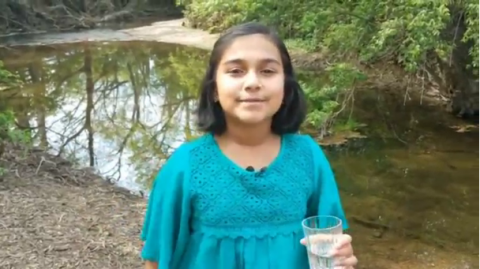
NEW YORK, United States (Reuters) — Gitanjali Rao, an 11-year-old from Lone Tree, Colorado, won the 2017 Discovery Education 3M Young Scientist Challenge for inventing Tethys, a device that detects lead in water.
“Tethys, the Greek goddess of fresh water, is a lead detection tool,” Rao said. “What you do is first dip a disposable cartridge, which can easily be removed and attached to the core device in the water you wish to test. Once you do that, that’s basically the manual part. Then you just pull out an app on your phone and check your status and it looks like the water in this container is safe. So that’s just very simple, about like a 10 to 15 second process.”
Rao was affected by the Flint, Michigan water catastrophe when the city switched its water supply in 2014, sparking a crisis that was linked to an outbreak of Legionnaires’ disease and at least 12 deaths, as well as exposure of residents to dangerously high lead levels.
“And I also realized that it wasn’t just in Flint, Michigan and there were over 5,000 water systems in the U.S. alone. In the beginning of my final presentation at the event, I talked about a little boy named Opemipo, he’s 10 years old and lives in Flint, Michigan. And he has 1 percent elevated lead levels in his blood. And he’s among the thousands of adults and children exposed to the harmful effects of lead in water. So it’s a pretty big deal out there today,” she recounted.
The Flint, Michigan water crisis erupted in 2015 after tests found high amounts of lead in blood samples taken from children in the industrial city of about 100,000, whose population is predominantly black.
The city had started using the Flint River for water in 2014.
Water to Flint from the Great Lakes Water Authority comes from Lake Huron.
The more corrosive river water caused lead to leach from pipes and into the drinking water.
The young scientist, a seventh-grader at STEM School Highlands Ranch, said it took her five months to make Tethys from start to finish.
“My first couple of times when I was doing my experimentation and test, I did fail so many times and it was frustrating, but I knew that it was just a learning experience and I could definitely develop my device further by doing even more tests and getting advice from my mentor as well,” she said. “So, never be afraid to try.”
Rao won “America’s Top Young Scientist” award along with a $25,000 prize.








